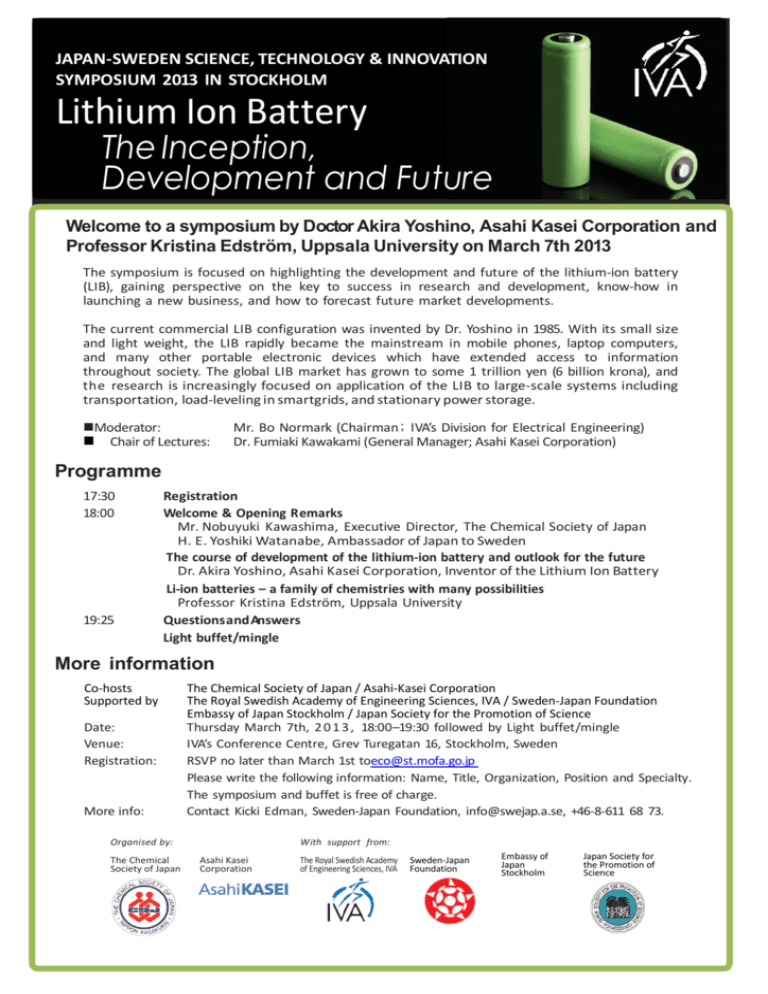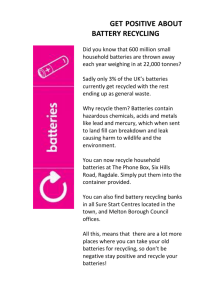Lithium Ion Battery
advertisement

JAPAN-SWEDEN SCIENCE, TECHNOLOGY & INNOVATION SYMPOSIUM 2013 IN STOCKHOLM Lithium Ion Battery The Inception, Development and Future Welcome to a symposium by Doctor Akira Yoshino, Asahi Kasei Corporation and Professor Kristina Edström, Uppsala University on March 7th 2013 The symposium is focused on highlighting the development and future of the lithium-ion battery (LIB), gaining perspective on the key to success in research and development, know-how in launching a new business, and how to forecast future market developments. The current commercial LIB configuration was invented by Dr. Yoshino in 1985. With its small size and light weight, the LIB rapidly became the mainstream in mobile phones, laptop computers, and many other portable electronic devices which have extended access to information throughout society. The global LIB market has grown to some 1 trillion yen (6 billion krona), and the research is increasingly focused on application of the LIB to large-scale systems including transportation, load-leveling in smartgrids, and stationary power storage. Moderator: Chair of Lectures: Mr. Bo Normark (Chairman; IVA’s Division for Electrical Engineering) Dr. Fumiaki Kawakami (General Manager; Asahi Kasei Corporation) Programme 17:30 18:00 19:25 Registration Welcome & Opening Remarks Mr. Nobuyuki Kawashima, Executive Director, The Chemical Society of Japan H. E. Yoshiki Watanabe, Ambassador of Japan to Sweden The course of development of the lithium-ion battery and outlook for the future Dr. Akira Yoshino, Asahi Kasei Corporation, Inventor of the Lithium Ion Battery Li-ion batteries – a family of chemistries with many possibilities Professor Kristina Edström, Uppsala University Questions and Answers Light buffet/mingle More information Co-hosts Supported by Date: Venue: Registration: More info: The Chemical Society of Japan / Asahi-Kasei Corporation The Royal Swedish Academy of Engineering Sciences, IVA / Sweden-Japan Foundation Embassy of Japan Stockholm / Japan Society for the Promotion of Science Thursday March 7th, 2 0 1 3 , 18:00–19:30 followed by Light buffet/mingle IVA’s Conference Centre, Grev Turegatan 16, Stockholm, Sweden RSVP no later than March 1st toeco@st.mofa.go.jp Please write the following information: Name, Title, Organization, Position and Specialty. The symposium and buffet is free of charge. Contact Kicki Edman, Sweden-Japan Foundation, info@swejap.a.se, +46-8-611 68 73. Organised by: The Chemical Society of Japan With support from: Asahi Kasei Corporation The Royal Swedish Academy of Engineering Sciences, IVA Sweden-Japan Foundation Embassy of Japan Stockholm Japan Society for the Promotion of Science Profile of Dr. Akira Yoshino Akira Yoshino (born in 1948 in Osaka) is a Japanese chemist. In 1972 he received an M.S. from the Department of Petrochemistry, Graduate School of Engineering, Kyoto University, and entered Asahi Kasei Corp. In 2003 he became a Fellow at Asahi Kasei Corp. In 2005 he received a Dr. Eng. from the Graduate School of Engineering, Osaka University, and became General Manager, Yoshino Laboratory, Asahi Kasei Corp. In 2010 he became President of the Lithium Ion Battery Technology and Evaluation Center (LIBTEC). In 2011 he became Adjunct Professor, Graduate School of Engineering, Kyoto University. In 2012 he became a Fellow of the Chemical Society of Japan. Abstract The course of development of the lithium-ion battery and outlook for the future The lithium ion battery (LIB) is defined as “a nonaqueous secondary battery using transition metal oxides containing lithium ion such as LiCoO2 as a positive electrode and carbonaceous material as a negative electrode.” The LIB is widely used in the power supply of mobile phones, laptop computers, and various other portable electronic devices, and its use is now expanding into electric vehicles and stationary power storage applications. Many twists and turns occurred between 1981, when the development of the lithium-ion battery began, and the present day. The lecture describes the course of development, including several anecdotes about interesting incidents which occurred along the way. Based on this experience, Dr. Yoshino offers his perspective on the key to success in research and development, know-how in launching a new business, and how to forecast future market developments. The first test-tube LIB cell (1983) Major Awards 1999 Fiscal 1998 Chemical Technology Prize, from the Chemical Society of Japan 1999 Battery Division Technology Award, from The Electrochemical Society 2001 Ichimura Prizes in Industry—Meritorious Achievement Prize, from the Ichimura Foundation 2004 Medal with Purple Ribbon, from the Government of Japan 2011 Yamazaki-Teiichi Prize, from the Foundation for Promotion of Material Science and Technology of Japan 2011 C & C Prize, from the NEC C & C Foundation 2012 IEEE Medal for Environmental and Safety Technologies, from the Institute of Electrical and Electronics Engineers Profile of Professor Kristina Edström Kristina Edström is a professor in inorganic chemistry at Uppsala University. She received her PhD. in 1990 on a thesis about the solid electrolyte in sodium-sulphur batteries. Currently she is a leader of the largest Li-ion battery research group in the Nordic countries with activities covering new anode and cathode materials for Li-ion and Na-ion batteries, Li-S and LiO2 batteries. Development of in situ methods for studying the complex reactions occurring in the batteries during battery operation is one major activity of the research group. Edström is a member of the Royal Academy of Engineering Sciences and a board member of Uppsala University as well as of the Swedish Foundation for Strategic Research. Li-ion batteries – a family of chemistries with many possibilities Kristina Edström Department of Chemistry – Ångström Laboratory, Uppsala University, Box 538, SE 751 21 Uppsala, Sweden Despite the fact that Li-ion batteries are influencing our daily lives by powering portable electronic equipments there are still room for new materials and combination of chemistries that can give batteries with enhanced performances. In this presentation focus will be on the latest developments and challenges when it comes to new anode and cathode materials for Li-ion batteries and for their use in automotives and for large scale storage. The future high energy systems such as Li-O2 and Li-S batteries will also be discussed in terms of possibilities and challenges. The current research will be described. Silicon anodes will be used as one example to demonstrate the importance to understand the complex chemistry occurring at interfaces between the electrolyte and the electrode material. Interfaces in the Li-ion batteries are influencing thermal stability, self-discharge properties and how fast a battery can be charged or discharged. It will be shown that the electrolyte composition plays an important role for cycling stability and how the latest developments of synchrotron based technologies can lead to better understanding of complex processes. One example is shown in figure 1 where a silicon electrode has been studied with HAXPES (Hard X-ray Photoelectron Spectroscopy). The silicon was cycled in a Li-ion battery with a standard electrolyte and the schematics of the kind of surface that will grow on the silicon particle is shown in the figure. Also new cathode materials will be discussed where the focus is on high capacity and high voltage batteries leading to batteries with higher energy than the commercially used batteries of today. Figure 1. The Silicon 2p spectra of silicon electrodes cycled in a standard electrolyte. The schematic picture shows that the salt in the electrolyte will react with the surface of the silicon. B. Philippe et al., Chem. Mater (2013) in press.





